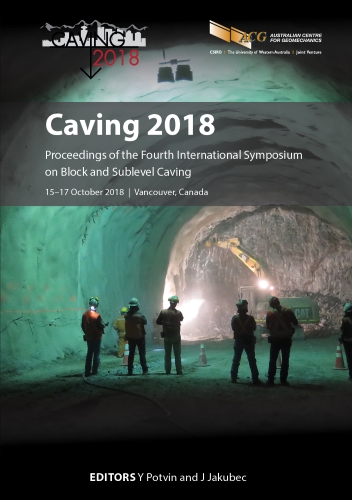Rapid mine development using efficient in-cycle shotcrete

|
Authors: Erismann, F; Lindlar, B; Munoz, C; Hansson, M; Erlangga, R |
DOI https://doi.org/10.36487/ACG_rep/1815_59_Erismann
Cite As:
Erismann, F, Lindlar, B, Munoz, C, Hansson, M & Erlangga, R 2018, 'Rapid mine development using efficient in-cycle shotcrete', in Y Potvin & J Jakubec (eds), Caving 2018: Proceedings of the Fourth International Symposium on Block and Sublevel Caving, Australian Centre for Geomechanics, Perth, pp. 759-766, https://doi.org/10.36487/ACG_rep/1815_59_Erismann
Abstract:
Fibre-reinforced shotcrete has proven to be the material of choice when it comes to rapid and efficient underground support in large mining projects. For large block caving projects, in-cycle shotcrete is particularly interesting as it allows rapid footprint development, thus shortening the construction time to access first ore from drawpoints. Application speed, applicability, yielding characteristics, durability and strength are the main favourable characteristics that make fibre-reinforced, sprayed concrete the go-to primary support component in most block and sublevel cave operations around the globe. However, integrating an effective shotcrete setup in mining operations requires good know-how in concrete production, spray application and the selection of the best performing materials. Lessons learned from projects such as El Teniente, Grasberg, Kiruna, Chuquicamata and others are part of this paper. Particular focus is given on the screening of the right mix design for a given mining operation. Finding an optimised solution in terms of the accelerator and admixture selection, the choice of the right fibre and dosage as well as optimising the mix design from a cost performance perspective are key to harvesting the main benefits of an integrated shotcrete support. By doing so, the shotcrete will yield its main benefits such as high early strength development that allows fast re-entry time after spraying and high energy absorption capabilities of the cured shotcrete liner to cope with the expected lithostatic and mininginduced loads and deformations. A tool that has been proven successful is the Sika MiniShot device. It is a scaled down laboratory tool to efficiently screen for the right and best performing shotcrete mix in a fast and lean way.
Keywords: shotcrete, mining, accelerator, admixture, Sika
References:
Austrian Society for Construction Technology 2004, Sprayed Concrete Guideline, Austrian Society for Construction Technology, Vienna.
European Committee for Standardization 2007, EN-934-5:2007, Admixtures for Concrete, Mortar and Grout – Part 5: Admixtures for Sprayed Concrete – Definitions, Conformity, Making and Labelling, European Committee for Standardization, Brussels.
Lindlar, B, Oblak, L, Lootens, D & Stenger, C 2014, ‘From tunnel to laboratory: Scaling of shotcrete testing’, in T Beck, O Woldmo & S Engen (eds), Proceedings of the Seventh International Symposium on Sprayed Concrete – Modern Use of Wet Mix Sprayed Concrete for Underground Support, Tekna – The Norwegian Society of Graduate Technical and Scientific Professionals, Oslo, pp. 282–286.
Lootens, D, Hansson, M, Oblak, L & Lindlar, B 2014, ‘Ultrasonic wave propagation for strength measurements: Application in shotcrete’, in T Beck, O Woldmo & S Engen (eds), Proceedings of the Seventh International Symposium on Sprayed Concrete – Modern Use of Wet Mix Sprayed Concrete for Underground Support, Tekna – The Norwegian Society of Graduate Technical and Scientific Professionals, Oslo, pp. 287–293.
Norwegian Concrete Association 2001, Sprayed Concrete for Rock Support, Publication No. 7, Norwegian Concrete Association, Oslo.
Oblak, L, Lindlar, B & Lootens, D 2012, ‘Continuous monitoring of strength evolution of shotcrete’, in W Kusterle (ed.), Proceedings of the 10th Shotcrete Conference (Spritzbeton-Tagung 2012).
Schlumpf, J 2017, Sika at Work, Gotthard Base Tunnel – Project of the Century, Sika special publication, Sika Services AG, Zürich.
© Copyright 2025, Australian Centre for Geomechanics (ACG), The University of Western Australia. All rights reserved.
View copyright/legal information
Please direct any queries or error reports to repository-acg@uwa.edu.au
View copyright/legal information
Please direct any queries or error reports to repository-acg@uwa.edu.au
